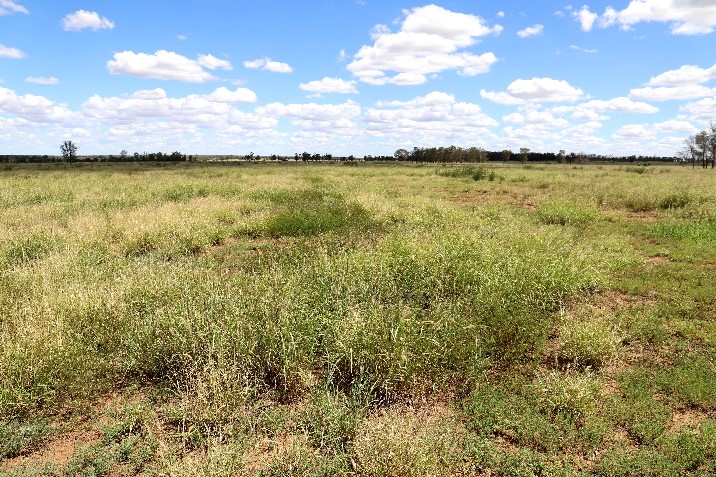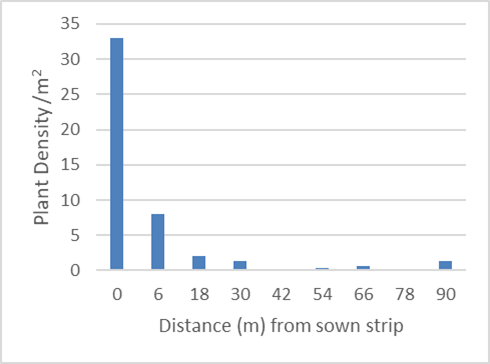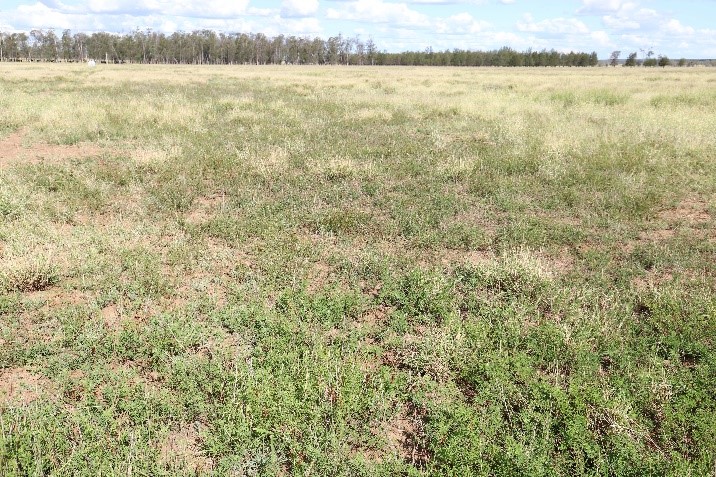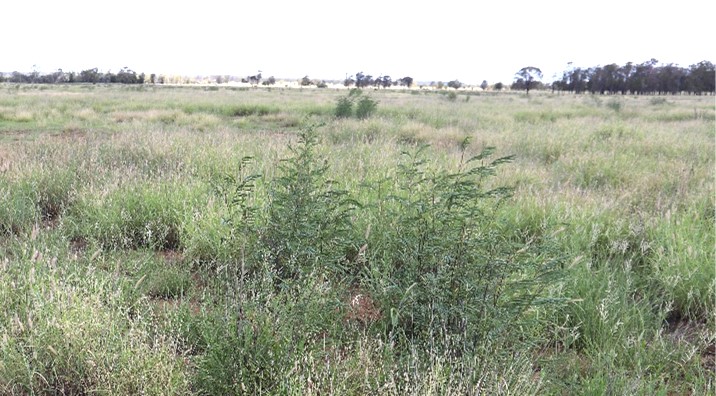Desmanthus and leucaena strips: spread and persistence at Dulacca
Mike and Judy Johnson sowed leucaena and desmanthus in cultivated strips in a buffel grass paddock near Dulacca in 2008. Leucaena grew well initially, has persisted in some parts of the paddock, but is dying out in other sections. Meanwhile, desmanthus has persisted and spread from the strips where it was sown.
| Names: | Mike, Judy and Dan Johnson |
| Property: | 'Bidson', Dulacca, Queensland |
| Existing pastures: | Buffel cv. Gayndah, leucaena cv. Cunningham and cv. Tarramba, desmanthus cv. Marc, and native pastures |
| Soils and land types: | Brigalow-Belah scrub, Brigalow with melon holes, and Poplar box with brigalow |
| Enterprise: | Beef cattle and grain |
Legumes sparked an interest
Many of the grazing paddocks at ‘Bidson’ near Dulacca in southern Queensland are sown to summer-growing, improved pastures. Owners Mike and Judy Johnson, and their son Dan and family, run the property as a beef breeder enterprise paired with grain production.
The property receives about 570 mm of rain each year with around 70% falling in the warmer months October to March (Whitbread et al 2009). Bidson was sown to buffel pastures in the 1970s and during the early 2000s the family hosted research trials for a range of pastures varieties.
Having heard about the benefits of legumes and seen the successes other growers were having with leucaena – as well as the results from the desmanthus trials on his property – Mike decided to sow his first paddock in 2008. Desmanthus and leucaena produce high quality feed and are persistent even in dry conditions. Both desmanthus and leucaena are especially valuable when the quality of tropical grasses drops at the end of summer.
Desmanthus and leucaena in strips
Mike decided to sow an existing buffel grass paddock with strips of ‘Cunningham’ leucaena and ‘Marc’ desmanthus. The strips were sown with leucaena in twin rows, spaced 12 m apart, and swapped with desmanthus every 16th strip.
“We prepared the strips in the paddock by spraying out the existing grass then deep ripping and cultivating the soil,” Mike said. “And then fallowed for about 15 months and planted using a leucaena planter. We followed that up with a post-emergence herbicide and followed the recommendations for successfully establishing leucaena.”

Using strips to establish legumes — leucaena, desmanthus or many other varieties — into existing grass pastures is gaining interest among graziers who wish to improve pasture productivity but are hesitant to plough out the existing grass across the whole paddock.

The recommended method for sowing leucaena in strips into an existing grass-only paddock is to cultivate or spray out 4-5 m wide strips to create a clean seedbed between grass strips (Shelton et al 2021). Established grass has a much bigger root system than tiny new legume seedlings and, if growing close together, will out-compete the seedling for moisture.
The width of grass left between each strip depends on whether you are sowing in a high or low rainfall zone. The recommendation for leucaena is to sow hedgerows 10 to 12 m apart in drier districts, and as close as 5 to 7 m in areas with higher rainfall (Shelton et al 2021). More information on using strips for leucaena can be found in ‘Leucaena: the productive and sustainable forage legume’ booklet (Shelton et al 2021) available on the Meat and Livestock Australia website.
Legume establishment and spread
There have been many dry and challenging years since the leucaena and desmanthus strips were sown at Bidson. In 2020-2021, spring and summer rain produced plenty of pasture growth and the desmanthus had spread wider than the strips it was sown.
“We have seen the desmanthus in this paddock spreading into parts of the paddock we didn’t even sow it,” Mike shared.
In February 2021, plant density measures were collected to study the distance of desmanthus spread from its original sown strips. The graph below (Figure 3), shows the desmanthus plant count along a transect running perpendicular to the sown rows.

Most of the desmanthus plants were found up to 20 m of the original sown strip, but scattered plants were found beyond that among the buffel and leucaena throughout the paddock.

In 2021, the 12 year old leucaena plants were not growing very well in this paddock or producing much dry matter. Some hedgerows had died out completely with some plants recovering from the dry conditions with new shoots, but all had been well grazed and averaged 1 m tall. Mike has established additional paddocks with leucaena and desmanthus since sowing this first one. He has used different leucaena varieties in these paddocks which are producing more dry matter, however their long-term persistence is still to be proven.

In 2011, Queensland Department of Agriculture and Fisheries researchers conducted a study of 40 historic legume evaluation trials spanning more than 20 years, they found desmanthus persisted at more locations than leucaena in southern and central Queensland.
Top tips with pasture legumes
Mike is happy with the improvements he’s seen after incorporating legumes with his pastures. His top tip for others considering sowing legumes is:
“Don’t take short cuts: prepare your paddocks right the first time in order to improve your chance of successful legume establishment.”
Acknowledgement
This project is jointly funded through Meat and Livestock Australia and Department of Agriculture and Fisheries.
© State of Queensland (Department of Agriculture and Fisheries). Published 2022.
Compiled by Louise Walker, Sown Pasture Agronomist, Department of Agriculture and Fisheries.
More information
Species information
Queensland Department of Agriculture and Fisheries: https://www.daf.qld.gov.au/business-priorities/agriculture/plants/crops-pastures/pastures/
Row spacing and planting:
The Leucaena Network Factsheet #5: Planting. The Leucaena Network: https://www.leucaena.net/fact-sheets
Shelton M., Dalzell S., Tomkins N., Buck S. (2021) Leucaena: the productive and sustainable forage legume. Meat and Livestock Australia, Sydney, Australia. https://www.mla.com.au/research-and-development/Grazing-pasture-management/leucaena-hub/
‘Bidson’ pastures research paper:
Whitbread A. M., Hall C. A., Pengelly B. C. (2009) A novel approach to planting grass–legume pastures in the mixed farming zone of southern inland Queensland, Australia. Crop and Pasture Science 60, 1147-1155 https://doi.org/10.1071/CP09058